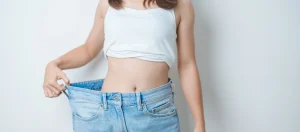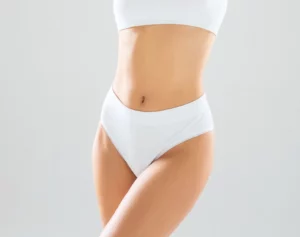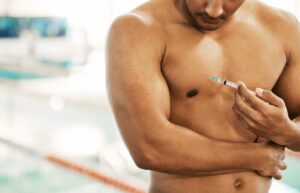After a tummy tuck, wearing a compression garment is a crucial part of your recovery. The garment should fit snugly enough to provide support and reduce swelling, but not so tight that it causes discomfort, restricts breathing, or interrupts blood flow. A good rule of thumb is that it should feel firm and supportive, like a gentle hug around your midsection, rather than being painfully tight. You should be able to move, sit, and breathe normally while wearing it.
Understanding how tight your compression garment should be can make a significant difference in your healing and your final results. Below, we’ll explore why the right fit matters, how it affects your recovery process, and what to look for when choosing the compression garment after tummy tuck surgery.
The Role of Compression Garments in Cosmetic Surgery
In cosmetic surgery procedures, such as a tummy tuck, liposuction, or a body lift, surgeons often recommend the use of compression garments to support the healing process. These garments help stabilize tissues and prevent fluid buildup under the skin. By applying consistent, gentle pressure, they promote smoother results and help reduce the risk of complications.
After a tummy tuck, your abdomen will be swollen and tender for several weeks. The compression garment helps hold everything in place while minimizing strain on your incision sites. Without adequate support, the tissue may heal unevenly or develop excess fluid (seroma), which can delay recovery.
Finding the Best Compression Garment
The best compression garment for tummy tuck recovery is one that fits properly, feels comfortable, and provides even compression across the treated area. It should not pinch, roll, or create indentations in your skin. Quality garments are typically made from breathable, medical-grade materials that maintain consistent pressure while allowing airflow.
When shopping for the best compression garment, consider adjustable closures, soft inner linings, and flexible yet firm fabric. Some garments feature built-in panels that target specific areas, such as the lower abdomen, to enhance contouring results. If you’re unsure which style is right for you, ask your surgeon for recommendations. Many surgeons have preferred brands or can measure you for a custom fit during your pre-surgery consultation.
How Compression Helps Reduce Swelling
Swelling is a natural part of the body’s healing response after a tummy tuck. Fluid accumulates in the tissue as your body repairs itself. A compression garment helps reduce swelling by applying uniform pressure, which prevents excess fluid buildup and supports lymphatic drainage.
Consistent compression also improves comfort during recovery, as it minimizes the tight, heavy feeling often caused by fluid retention. Most patients notice that wearing their garment regularly helps their abdomen feel more secure and stable, especially when moving or standing upright.
Your surgeon will likely recommend wearing the garment continuously for several weeks, removing it only for brief periods to shower or wash. Over time, the swelling will decrease, and you may transition to a lighter or smaller-sized garment as your body heals.
Supporting the Recovery Process
The recovery process after a tummy tuck typically lasts several weeks to a few months, depending on the extent of your surgery and your overall health. During this period, compression garments play a significant role in ensuring your abdomen heals smoothly and maintains its new contour.
Proper compression supports your incision, reduces tension on sutures, and helps tissues adhere to their new position. It also prevents your skin from stretching or moving excessively during daily activities, which could affect your final results. Following your surgeon’s instructions about when and how to wear the garment is crucial. Wearing it too loosely can limit its effectiveness, while excessive tightness can interfere with blood flow and cause unnecessary discomfort.
Managing Loose Skin After Tummy Tuck
Although a tummy tuck removes excess skin and tightens the abdominal wall, some patients may still have areas of loose skin during the early stages of recovery. This is normal, as swelling and tissue adjustment take time. Compression garments help manage loose skin by providing external support and promoting even skin retraction.
Consistent pressure encourages the skin to conform to the new abdominal contour, resulting in smoother and firmer skin. If your garment is too loose, it may not offer enough support to guide this process. If it’s too tight, it may cause indentations or restrict healing. That’s why a properly fitted garment is key – it should feel secure and supportive, but never painful.
Importance of Blood Circulation
Proper blood circulation is essential for healing after any surgical procedure, including a tummy tuck. Adequate circulation helps deliver oxygen and nutrients to the tissues, which supports faster recovery and reduces the risk of complications such as delayed wound healing.
A compression garment that is too tight can interfere with blood flow, leading to numbness, tingling, or increased swelling in the area below the garment. Always check your skin for signs of restricted circulation, such as discoloration or coldness. If you experience these symptoms, contact your surgeon and loosen or remove the garment temporarily. The ideal compression level promotes circulation without constriction.
Choosing Between an Abdominal Binder and a Compression Garment
Some patients use an abdominal binder immediately after surgery, while others transition directly to a more structured compression garment. An abdominal binder is a wide, adjustable wrap that provides gentle compression and can be easier to put on during the early recovery phase when mobility is limited.
As healing progresses, many surgeons recommend switching to a fitted compression garment that covers a larger area and provides more even support. Both options have their benefits, and your surgeon will guide you on when to make the transition based on your individual needs.
The Value of Antibacterial Properties in Fabric
Modern compression garments often incorporate materials with antibacterial properties, which help maintain cleanliness and reduce the risk of infection during recovery. Since you’ll be wearing the garment for extended periods, moisture control and hygiene are essential. Antibacterial fabrics help prevent odor and bacterial growth, keeping the skin healthier and more comfortable.
Choosing a garment with this feature is particularly beneficial in warmer climates or for individuals prone to skin irritation. Ensure your garment is cleaned as recommended – typically by hand washing with mild soap and air drying – to maintain its elasticity and antimicrobial coating.
Understanding Recovery Time
The recovery time after a tummy tuck varies depending on the extent of the procedure and individual factors that affect healing. Generally, patients wear compression garments for six to eight weeks, although some may continue wearing them for an additional period for extra support. During the first few weeks, round-the-clock wear is usually required, followed by a gradual reduction as your body heals.
By the end of your recovery period, swelling should have decreased significantly, and your final abdominal contour will become more defined. Continuing to wear the garment as instructed can enhance your long-term results by helping the skin and tissue adapt properly.
Exploring Different Types of Compression Garments
There are different types of compression garments designed for tummy tuck recovery, including high-waisted briefs, full-body suits, and mid-thigh girdles. Each type offers unique coverage and compression levels depending on the surgical area.
High-waisted garments provide targeted support for the abdomen, while full-body designs also support the hips and thighs, helping maintain even pressure and smooth transitions between treated areas. Some garments come with zippers or hook-and-eye closures for easier dressing, while others rely on pull-on designs for a seamless look under clothing.
Your surgeon can help you choose the style and compression level that best suits your procedure and comfort preferences. Having more than one garment on hand allows you to rotate them for cleaning and continuous wear throughout your recovery.
Final Thoughts
Wearing the right compression garment after abdominoplasty surgery is essential for minimizing fluid accumulation, supporting the healing process, and ensuring that the underlying tissues heal smoothly. This popular body contouring surgery not only tightens the abdominal skin but may also include fat removal, making postoperative support crucial. The consistent pressure from compression clothing helps control postoperative swelling, allowing patients to achieve a flatter and more refined contour.
High-quality garments made from breathable materials provide comfort while maintaining the right amount of pressure to reduce friction against healing skin. By wearing your garment as directed and caring for your body during recovery, you can enhance your surgical outcome and enjoy long-lasting results from your tummy tuck.










